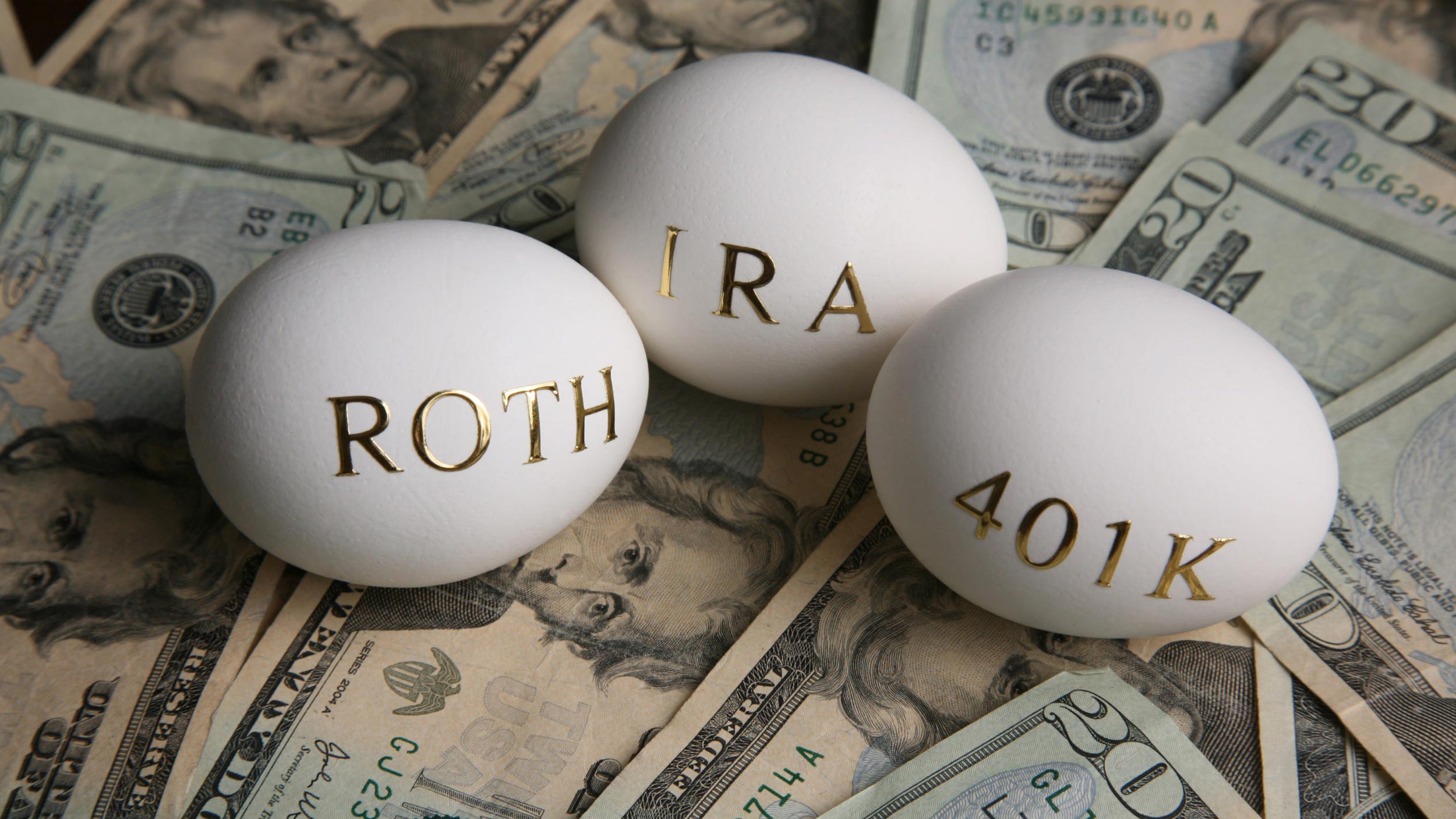The words “tax-free” should stand out when you first consider a Roth Solo 401k. The distinction between a tax-free Roth Solo 401k and a tax-deferred Solo 401k is important because it means you can use a Roth 401k to better manage your income taxes during retirement. A surprise to some new retirees is that most of their income sources are still taxable – including Social Security, traditional IRAs, and traditional 401ks. After you are retired, it may be too late to take advantage of the tax-free income provided by a Roth Solo 401k that Nabers Group provides at no extra charge.
What is a Roth Solo 401k?
A Roth Solo 401k is similar to a traditional Solo 401k except for the difference between the tax-free and tax-deferred savings. You can contribute to both a Roth Solo 401k and a traditional Solo 401k during the same tax year and split the contributions in whatever way you wish, as long as the total contribution amount is below the aggregate maximum contribution limit.
A Solo Roth 401k gives self-employed business owners a retirement boost that many business owners are not aware of. They may not be aware that they can set up a Solo 401k that resembles 401k plans offered by most major employers. But it gets much better because both a Solo 401k and Roth Solo 401k are almost always more generous on the profit-sharing side of the contribution. After all – you are the boss, which means you can choose to share all of your profit exclusively with your retirement account. Major corporations have hundreds of thousands of shareholders that they must share the biggest part of the profits with – rather than employees. As a result, corporations place limits on the annual amount of employee savings – both the employee and profit sharing (employer) amounts.
Not only can a self-employed business owner set up a Solo 401k, but it is also much more flexible than a corporate 401k. The Roth Solo 401k is part of that flexibility but so is the ability to make alternative investments and the ability to fully control your annual contributions from 100% to 0%. And with Nabers Group, that flexibility includes a Roth Solo 401k that is included free.
The similarities between the Solo 401k and the Roth Solo 401k include that both are for businesses with no full-time employees. Both also include one important employee exception – a spouse who earns income from the business can be part of both plans. Your spouse, as a full-time employee, can make the same employee contribution you can make as the business owner up to the legal limits, including catch-up provisions. An employed spouse can also receive the same percentage of employer contribution, up to the legal limit. This can allow your joint retirement contributions to be twice the amount as it would be with you as a single employee – and again, much higher than what almost every corporate account allows.
Here is the important tax distinction that you need to know about between the Solo 401k and Solo Roth 401k. The Solo 401k is the tax-deferred version (aka pre-tax savings). You deduct the contribution from your income the year it is made to lower that year’s tax bill. The earnings then grow tax-deferred until you begin making withdrawals during retirement. When withdrawals are made, taxes become due. The intention is that you will be in a lower tax bracket when making withdrawals and you will have avoided paying taxes on the contributions during your higher tax bracket years while employed.
A Roth Solo 401k takes a different approach to the tax savings. Roth Solo 401k savings are often referred to as post-tax savings with tax-free growth and tax-free withdrawals. This is why it is often referred to as tax-free. However, you do pay taxes on the contributions in the year the contributions are made. That is why 100% of the withdrawals are tax-free at retirement.
Two situations make the Roth Solo 401k an exceptionally desirable choice. One is at a time in your life when your income is low (usually at a young age). It can make good financial sense to pay the taxes on that income while in a lower tax bracket and allow it to grow tax-free for many years and remain tax-free at retirement. Another exceptionally good time to go with a Roth Solo 401k is when you expect an extraordinarily high rate of return on an investment because the earnings are tax-free at retirement. For instance, Nabers Group began investing in Bitcoin using a Roth Solo 401k in early 2013 because we expected the payoff to be extraordinary and gains will be tax-free whenever we’re ready to cash out and take our distribution at retirement age.
Something else to know about a Roth Solo 401k is that because the taxes have already been paid, you can withdraw contributed funds at any time after the account has been established for five or more years. You can begin withdrawing the tax-free earnings as soon as you reach age 59 1/2 and have the account for five or more years.
But remember, you don’t have to make a final decision between a Solo 401k and a Roth Solo 401k today. You can have both types of accounts and make contributions to either at any time.
Is a Solo 401k The Same as a Roth 401k?
Yes, a Solo 401k is the same as a Roth 401k except for the differences in the tax treatment mentioned in the section above. However, the difference between tax-deferred and tax-free funds does influence how you will want to manage the two.
The similarities are so close that you have the option to convert Solo 401k funds into Roth Solo 401k funds. This became possible when the IRS released an amendment in 2010 allowing in-plan Roth conversions. Nabers Group was the first document provider to begin offering these rollovers. Because the Roth Solo 401k is a subaccount of the Solo 401k, it allows you to convert a portion or even all your Solo 401k funds to Roth. Along with our expert team sharing best practices, articles, and guides with you, we also provide a Roth Conversion Calculator to compare the two alternatives with equal out-of-pocket costs to estimate the change in total net-worth at retirement. Nabers Group will never charge you any fees on in-plan conversions.
The main reason a Roth Solo 401k is a subaccount is due to the different tax treatment that requires the tax-deferred and tax-free funds to be managed differently. This makes bookkeeping much simpler and cleaner. During retirement, it also makes it easier to calculate required minimum distributions so that you further minimize taxes owed on the tax-deferred funds by knowing which funds you can remove tax-free.
The Solo 401k by Nabers Group allows you to take the maximum employee salary deferral contribution amount as a Roth contribution. This allows you to maximize your Roth contributions each year, but the amount you contribute is your choice. You can elect to contribute the entire amount or simply a portion of your employee salary-deferral contributions as Roth funds. Our team will provide access to contribution calculators and contribution forms so you can calculate the amount to contribute that’s right for you.
Can I Have Both a Roth IRA and a Roth Solo 401k?
The short answer is YES, you can have both a Roth IRA and a Roth Solo 401k. However, depending on your income level, having both might not be the best answer. Not only are the contribution limits much higher with a Roth Solo 401k but the Roth IRA has an income cap.
In 2021, to be eligible for a Roth IRA, single filers must have a modified adjusted gross income (MAGI) below $140,000, and married couples filing jointly must make less than $208,000. The income limits do not apply to Roth Solo 401k contributions.
Another huge benefit of the Roth Solo 401k plan is that it allows tax-free access to retirement funds via the participant loan feature. Neither traditional nor Roth IRAs allow participant loans.
Roth IRA vs Roth Solo 401k
The Roth Solo 401k has serious advantages over the Roth IRA for most self-employed business owners. The participant loan and lack of income cap lead the list. Add to that the potential for increases in federal and state income tax rates and the ability to generate tax-free returns makes the Roth Solo 401k the best surviving legal tax shelter.
The fact that people with high incomes can still contribute also pairs well with the higher contribution limits allowed with a Roth Solo 401k. Another advantage to the Roth 401k is the matching contributions you make as your own employer in the amount that you choose to make.
The Roth Solo 401k also avoids the Unrelated Debt Financed Income (UDFI) tax that does apply to a Roth IRA. UDFI is a tax that applies when you borrow money to help finance your investments. The Roth Solo 401k is not subject to UDFI, but the Roth IRA is subject to this high tax that can be as much as 37% in 2022.
The one advantage of the Roth IRA is that you do not have to take required minimum distributions (RMDs) – ever. If you retire and you have other assets to live off, you can leave the money in your Roth IRA and allow it to continue growing for as long as you like. However, youcan avoid RMDs by rolling over your Roth 401k into a Roth IRA when the time comes.
The Mega Backdoor Roth Solo 401k
But… there is one huge advantage to the Roth IRA called the Mega Backdoor Roth IRA. A Mega Backdoor Roth IRA can avoid the taxable event that a normal Roth IRA conversion often creates if you meet the income and savings requirements. A Mega Backdoor Roth IRA is a great vehicle for diversifying your retirement income – granting you both tax-deferred income on your pre-tax contributions and tax-free income on your after-tax contributions.
A Mega Backdoor Roth Solo 401k allows you to contribute more after-tax dollars than you would in a normal Roth IRA, based on IRS guidance in 2014. The result is that you can eventually take the funds out of the Roth 401k/IRA without tax penalty.
This strategy is not for everyone but is a valuable strategy for high earners who don’t qualify to contribute directly to a Roth IRA or those who want to get more savings and assets into a Roth IRA structure. This is a complex strategy that requires meticulous calculation and excellent documentation. The Nabers Group Solo 401k plan has all the elements needed for the Mega Backdoor Roth strategy.
Roth Solo 401k Contribution Limits
Along with higher contribution limits, frequent increases in the contribution limits are another reason the Roth Solo 401k is superior to the Roth IRA. In November 2021, the IRS announced changes to 401k plans for 2022 allowing employees under the age of 50 to contribute up to $20,500 per year to their Solo 401k, an increase of $1,000 from 2021. The catch-up contribution for employees age 50 and older is $6,500, for a total contribution limit of $27,000. The combined total employer and employee contributions cannot exceed $61,000 for the year, and $67,500 for employees age 50 and older.
On the other hand, 2022 traditional and Roth IRA contribution limits remain unchanged at $6,000 per year, with an additional $1,000 per year catch-up contribution for those age 50 and older.
Is a Solo 401k Worth It?
One of the few positives to come out of the isolation imposed by the pandemic is a powerful desire for more control over our lives. Many of us learned that we could work very well at home alone. That we don’t need nearly the amount of supervision that others thought was necessary. In fact, this is carrying over into today’s workplace by people choosing not to return to the corporate office or other controlling workspaces. People found that they can do the job just fine on their own – thank you!
Maybe it’s not only about control. Many people are refusing to return to minimum wage and low-paying jobs that have no future. It all adds up to empowering people to take full control of their lives. For many, it means becoming self-employed whether that is full-time or part-time. Both versions can lead to a very wealthy retirement through a Solo 401k that is fully self-controlled and far away from corporate bosses and Wall Street greed.
Ultimately, people want to have more control over their finances, time, and location!
But what about the security of an employer-sponsored retirement account? Well, if you’re not quite ready to give up some control over your retirement funds, you can begin by having it both ways. Yes, you can have a W-2 retirement account and a Solo 401k. You can also roll over old W-2 retirement funds into a Solo 401k. One of the easiest ways to get started is by turning a hobby into a business.
- If you’re self-employed and don’t employ others, you are eligible to open a Solo 401k.
- Spouses running a business together also qualify.
- You contribute to your Solo 401k as both employer and employee.
- For 2022, you can contribute a combined total between employer and employee of $61,000. If you’re age 50 or over, you can add another $6,500 for a total of $67,500.
- You can choose between a traditional plan, a Roth plan, or both.
Setup Your Solo 401k Today
Opening your Solo 401k involves very little work for a ton of benefits. Claim Your $61,000 Tax Deduction today!
A Solo 401k retirement plan is easy to set up and allows for tax-deductible contributions much larger than an IRA or standard 401k… plus it puts you in control.
Your Solo 401k plan is IRS-approved and contains an IRS Determination Letter and individual plan serial number proving the qualified status of your Solo 401k retirement plan. Additionally, your Solo 401k plan includes:
- Customized rollover document preparation
- Adoption Agreement
- Basic Plan Document
- Trust Agreement
- Summary Plan Description
- Appointment & Acceptance of Trustee
- Action by Board of Directors
- Beneficiary Designation Forms
- Required Minimum Distribution Forms
- Death Distribution Forms
- In-plan Roth Conversion notice & forms
- Hardship withdrawals
- Participant Loan and loan policy
- Loan origination documents
- Life Insurance policy
- IRS Opinion Letter and Plan serial number
- 401k Trust Tax ID number registered with the IRS
External links
Total contribution amount
https://www.irs.gov/retirement-plans/one-participant-401k-plans
IRS released an amendment in 2010
https://www.irs.gov/pub/irs-drop/n-10-84.pdf
IRS guidance in 2014




